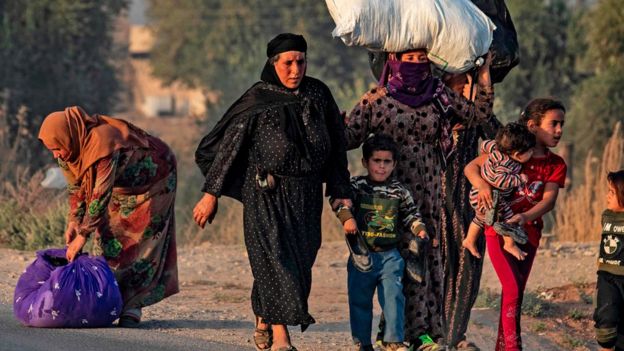Turkish forces are stepping up air strikes and a ground offensive, as their incursion into Kurdish-held areas of northern Syria enters a second day.
Turkey’s military said it had seized designated targets. There are reports of heavy fighting in the central border region, and seven civilian deaths.
Tens of thousands of people are reported to be leaving their homes.
The assault on Kurdish-led forces, key US allies, follows US President Donald Trump’s decision to withdraw US troops.
Turkey says it wants to create a “safe zone” on the border for many of the Syrian refugees on its territory.
On Wednesday, US Secretary of State Mike Pompeo denied the US had given Turkey a “green light” for the offensive.
But Mr Trump told a news conference the Turks and Kurds had “been fighting each other for centuries”, and said that Kurdish fighters “didn’t help us in the Second World War, they didn’t help us with [the D-Day landings in] Normandy”.
“With all of that being said, we like the Kurds,” he added.
Republicans and Democrats alike have condemned the decision to pull back US troops.
What is happening on the ground?
Kurdish sources report a large ground offensive between the towns of Ras al-Ain and Tal-Abyad, in the central area of Syrian’s northern border with Turkey.
Turkish-backed Syrian rebels from the Free Syrian Army have also been involved in the fighting.
The area is sparsely populated and mainly inhabited by Arabs.
Ras al-Ain has been hit by numerous air strikes. Eyewitnesses spoke of military jets circling and shelling by artillery.

Turkey’s defence ministry said on Twitter that its operation had continued successfully through the night by land and air. Reports say a number of villages east of Tal-Abyad were captured.
The Kurdish Red Crescent said at least seven civilians had so far been killed, two of them children, and at least 19 more critically injured including four children.
There are no clear estimates of numbers of displaced, but Kurdish sources say tens of thousands at least have left their homes.

Kurdish authorities accused Turkey of shelling a prison holding Islamic State (IS) group prisoners in Qamishli in the east of the border region in a “clear attempt” to help them escape.
Kurdish authorities have called for a general mobilisation and urged people to “head to the border with Turkey… to resist in this sensitive, historic moment”.
What resistance can the Kurdish-led forces offer?
The Kurdish-led Syrian Democratic Forces (SDF) currently number about 40,000 fighters, with tens of thousands of others in parallel Kurdish security services, Kurdish sources say.
The US joint task force on operations against IS in Iraq and Syria describes them as “tenacious fighters with a degree of basic military training to function as infantrymen”.
But they are deficient in heavy weaponry that could be used against tanks or aircraft, though some units may have anti-tank missiles.
In operations against IS, they relied on close coalition air support but in the flat, open country of Syria’s northern border they will be vulnerable to air and artillery attack.



